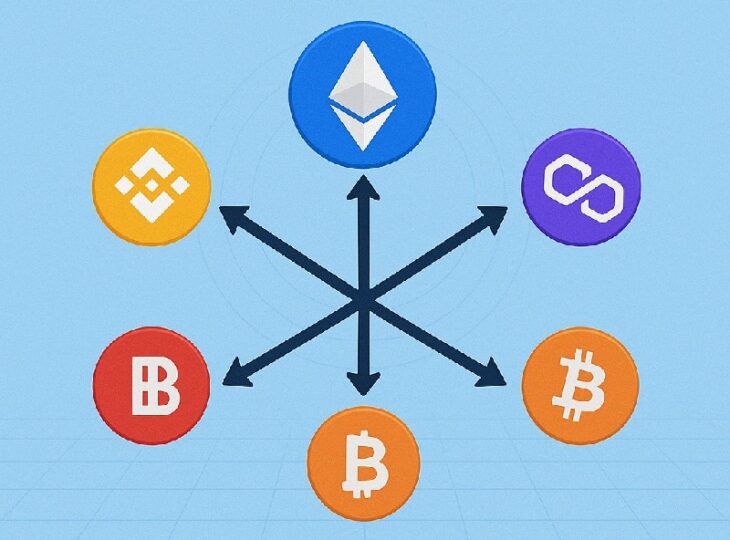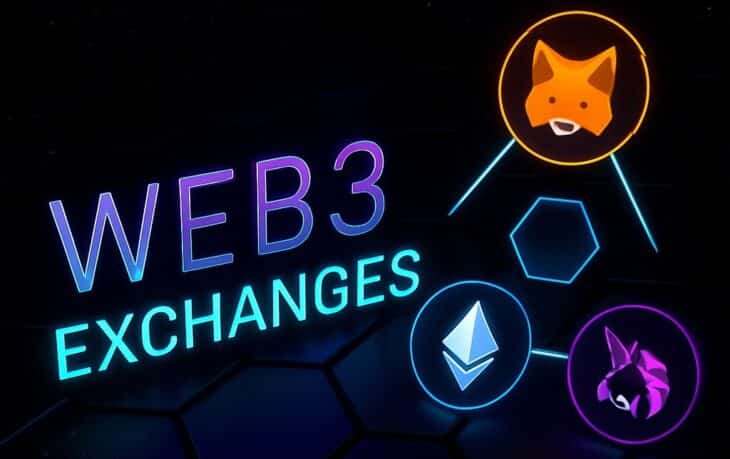Web3 exchanges are changing how people use blockchain assets. Instead of relying on centralized platforms with limited control, users now trade directly through decentralized systems. These exchanges use smart contracts to automate transactions, giving more freedom, security, and transparency to users. The focus has shifted toward personal control and real asset utility.
Many trading platforms now update their systems to keep up with user demand and technological growth. BYDFi is one example that continues to refine its platform to support faster trading and better cross-chain features.
Upgrades like these help users access more tokens, more tools, and smoother experiences across different blockchain networks.
The article will break down what Web3 exchanges actually do, how they function, and why they matter.
What Makes Web3 Exchanges Different from Traditional Platforms

Decentralized exchanges, often referred to as Web3 exchanges, do not rely on third-party intermediaries. Instead, they use blockchain-based protocols that let users interact directly with the network.
This structure removes centralized control and avoids traditional restrictions tied to regulations, account verification, or withdrawal limits. Users maintain custody of their assets at all times, with full control over private keys.
In traditional exchanges like Coinbase or Binance, every trade passes through a central order book managed by the platform. Users deposit funds into custodial wallets owned by the exchange, exposing assets to potential loss during outages or breaches. Web3 exchanges eliminate this layer.
Platforms like Uniswap, SushiSwap, and PancakeSwap run through smart contracts, where users connect wallets such as MetaMask and initiate trades directly with the protocol.
Key Differences Between Web2 and Web3 Exchanges
| Feature | Traditional Exchange | Web3 Exchange |
| Custody | Centralized wallet | User-controlled wallet |
| Trust | Requires platform trust | Trustless via smart contracts |
| Access | Often KYC-gated | Open to anyone with a wallet |
| Downtime Risk | Subject to maintenance | Network-level uptime |
| Order Matching | Central order book | Automated market makers |
How Smart Contracts Replace Middlemen

Smart contracts are blockchain-based scripts that automatically carry out actions once certain conditions are met. On Web3 exchanges, they replace the role of middlemen by handling every part of a trade: initiating, verifying, settling, and recording it without human oversight.
In centralized systems, exchanges match buyers and sellers, hold both funds during the trade, and release assets after confirmation. In a decentralized setup, the smart contract controls the flow entirely.
It receives tokens from one user, confirms the match and amount, and then sends the correct tokens to each party involved. No central entity steps in, which lowers counterparty risk.
Examples of Smart Contract Use in Web3 Trading
- Token Swaps: Protocols like Uniswap and Curve use smart contracts to automate token exchanges at dynamic rates through liquidity pools.
- Escrow Mechanisms: Contracts hold funds temporarily during complex trades or peer-to-peer transfers until both sides fulfill their roles.
- Fee Allocation: Smart contracts distribute transaction fees to liquidity providers without needing manual input.
How Trust Is Built Without Middlemen
Smart contracts are transparent. Users can view the code on explorers like Etherscan and confirm how funds move. Audits from firms such as CertiK or Trail of Bits further validate that the contract behaves as intended.
This direct, code-based verification replaces the need for trust in a third party.
The removal of middlemen speeds up transactions and lowers costs.
Liquidity Pools and Token Swaps Made Simple
Decentralized exchanges rely on liquidity pools instead of order books. Each pool contains pairs of tokens provided by users who earn fees in return. Instead of waiting for a matching buyer or seller, a trader simply swaps one token for another directly through the pool.
The price of each token depends on the ratio of tokens in the pool. This pricing follows an automated formula, most commonly x * y = k, where x and y are the quantities of each token and k is constant.
As trades occur, the pool adjusts prices dynamically. Larger trades move the price more significantly, which creates a balance between cost and pool depth.
Liquidity Providers and Incentives
Users who provide liquidity are called LPs. They deposit equal values of two tokens into a pool and receive LP tokens in return. These tokens represent their share and allow them to withdraw their portion plus fees.
Incentive Model Overview:
| Role | Action | Reward |
| Liquidity Provider | Add token pair to pool | Earn trading fees (0.3% typical) |
| Trader | Swap tokens in pool | Pays small fee, instant execution |
| Protocol | Maintains smart contracts | May take a share of fees or govern pool settings |
Some pools offer additional rewards through yield farming, where LP tokens can be staked to earn native tokens like UNI, SUSHI, or CAKE.
Cross-Chain Compatibility and Asset Portability

Early decentralized exchanges limited activity to one blockchain. Users on Ethereum could only trade Ethereum-based tokens. That model changed with the rise of cross-chain bridges and new protocols that allow assets to move freely between networks.
Cross-chain compatibility enables users to shift value between blockchains like Ethereum, BNB Chain, Polygon, Arbitrum, and even Bitcoin-linked layers.
Interoperability tools use wrapped tokens, synthetic assets, or liquidity routers to coordinate trades across networks. For example, a user can trade a token from Avalanche for one on Ethereum using a bridge that locks the original token and issues an equivalent on the new chain.
Projects like Thorchain and Stargate Finance offer solutions for seamless multi-chain swaps without custodial interference.
How Cross-Chain Transfers Work
- Token Locking: The user sends a token to a smart contract or gateway on the source chain.
- Verification: The contract confirms the transfer using chain validators or relayers.
- Token Minting: A wrapped or synthetic token appears on the destination chain.
- Redemption: The wrapped token can be converted back to the original once moved in reverse.
Security, Custody, and Control in Web3 Models

Custody defines who holds the private keys. In centralized exchanges, users deposit assets into exchange-owned wallets. That puts the exchange in control of the funds. In Web3 models, control stays with the user.
The wallet belongs to the user, not the platform. Each transaction passes through user authorization via digital signatures.
Security in Web3 models depends on two things: contract reliability and key protection. Users manage their own wallets, typically through browser extensions like MetaMask or mobile apps like Trust Wallet.
No sign-in or account setup is required. Every action depends on the user’s key.
Custody Models Compared
| Custody Type | Asset Control | Risk Exposure | User Flexibility |
| Centralized | Platform-controlled | High (hacks, withdrawal blocks) | Low |
| Decentralized | User-controlled | Medium (key loss) | High |
Additional security layers include hardware wallets, multi-signature options, and contract audits. Risks still exist, such as phishing attacks and malicious smart contracts. To reduce these risks, platforms publish open-source code and rely on third-party audits.
Challenges Facing Web3 Exchanges
Despite rapid growth, Web3 exchanges still face technical, legal, and user-experience challenges. Many platforms run on congested networks, where fees spike under heavy use. Ethereum gas costs remain a major barrier.
While newer chains offer lower fees, fragmentation creates complexity for users.
Another issue involves regulatory pressure. Governments have started applying centralized exchange rules to decentralized platforms. That includes Know Your Customer (KYC) mandates, sanctions compliance, and taxation rules.
These laws conflict with the anonymous, borderless nature of Web3. As legal clarity remains low, developers and users must navigate uncertainty.
Ongoing Limitations
- Speed: Block confirmation time can delay transactions.
- Scalability: Many platforms cannot handle spikes in volume.
- User Interface: Wallets and contracts confuse new users.
- Security Audits: Not all contracts undergo full review.
The technology itself keeps improving. Layer-2 rollups like Arbitrum and zkSync reduce fees and speed up transactions. UX-focused wallets like Rabby and Coinbase Wallet make onboarding simpler.
Still, growth depends on solving these issues without removing the core principles of decentralization and self-control.
What the Future Holds for Blockchain Asset Use
Web3 exchanges have already reshaped how people engage with blockchain assets. They transformed passive holding into active participation. As new upgrades take hold, use cases will expand beyond trading.
Real-world assets like real estate, commodities, and equity shares can enter blockchain networks through tokenization.
Integration with traditional finance may increase, especially through hybrid models. Some exchanges already offer both centralized access and DeFi tools under one interface.
Wallets may soon support real-world IDs, credit access, and on-chain employment credentials.



